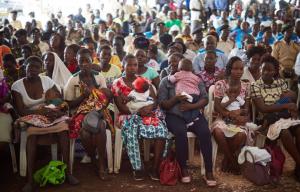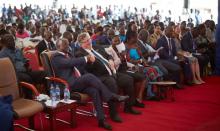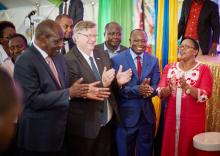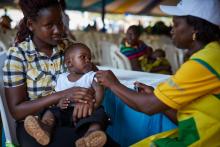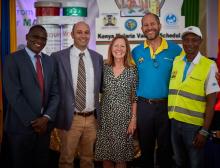Kenya rolls out landmark malaria vaccine introduction
Homa Bay, Kenya, 13 September 2019 – The World Health Organization (WHO) congratulates the Government of Kenya for launching the world’s first malaria vaccine today in Homa Bay County, western Kenya.
The malaria vaccine pilot programme is now fully underway in Africa, as Kenya joins Ghana and Malawi to introduce the landmark vaccine as a tool against a disease that continues to affect millions of children in Africa.
The vaccine, known as RTS,S, will be available to children from 6 months of age in selected areas of the country in a phased pilot introduction. It is the first and only vaccine to significantly reduce malaria in children, including life-threatening malaria.
Malaria claims the life of one child every two minutes. The disease is a leading killer of children younger than 5 years in Kenya.
“Africa has witnessed a recent surge in the number of malaria cases and deaths. This threatens the gains in the fight against malaria made in the past two decades,” said Dr Matshidiso Moeti, WHO Regional Director for Africa. “The ongoing pilots will provide the key information and data to inform a WHO policy on the broader use of the vaccine in sub-Saharan Africa. If introduced widely, the vaccine has the potential to save tens of thousands of lives.”
First vaccination: a day to celebrate
Distinguished health officials, community leaders and health advocates gathered in Homa Bay County – one of eight counties in Kenya where the vaccine will be introduced in selected areas – to mark this historic moment with declarations of support for the promising new malaria prevention tool and to demonstrate a ceremonial first vaccination of a 6-month-old child.
Speaking at the event, WHO Representative to Kenya Dr Rudi Eggers said: “Vaccines are powerful tools that effectively reach and better protect the health of children who may not have immediate access to the doctors, nurses and health facilities they need to save them when severe illness comes. This is a day to celebrate as we begin to learn more about what this vaccine can do to change the trajectory of malaria though childhood vaccination.”
Thirty years in the making, the vaccine is a complementary malaria control tool – to be added to the core package of WHO-recommended measures for malaria prevention, including the routine use of insecticide-treated bed nets, indoor spraying with insecticides and timely access to malaria testing and treatment.
Malaria vaccine implementation in Kenya
The Ministry of Health, through the National Vaccines and Immunization Programme, is leading the phased vaccine introduction in areas of high malaria transmission, where the vaccine can have the greatest impact.
The aim is to vaccinate about 120 000 children per year in Kenya across the selected introduction areas, including Homa Bay, Kisumu, Migori, Siaya, Busia, Bungoma, Vihiga and Kakamega counties. Within the eight counties, some sub-counties will introduce the vaccine into immunization schedules while others are expected to introduce the vaccine later.
More about the vaccine pilot programme
The WHO-coordinated pilot programme is a collaboration with the ministries of health in Ghana, Kenya and Malawi and a range of in-country and international partners, including PATH, a non-profit organization, and GSK, the vaccine developer and manufacturer, which is donating up to 10 million vaccine doses for this pilot.
Financing for the pilot programme has been mobilized through an unprecedented collaboration among three key global health funding bodies: Gavi, the Vaccine Alliance; the Global Fund to Fight AIDS, Tuberculosis and Malaria; and Unitaid.
________________________________________
Notes to editors:
• Proven results: Phase 3 clinical trials were conducted between 2009 and 2014 through a network of African research sites, including three sites in Kenya (Kombewa, Siaya and Kilifi) involving more than 4 000 Kenyan children. Children receiving four doses of RTS,S experienced significant reductions in malaria and malaria-related complications in comparison to those who did not receive RTS,S. Health benefits of the vaccine were in addition to those already seen through the use of insecticide-treated bed nets; prompt diagnosis; and effective antimalarial treatment.
• Child vaccination schedule in Kenya: The vaccine, where available, will be given in four doses: three doses between 6 months and 9 months of age, and the fourth dose at 24 months (age 2).
• Pilot countries: Kenya is one of three countries selected from among 10 African countries for the phased introduction of RTS,S following a request by WHO for expressions of interest. Key criteria for selection included well-functioning malaria and immunization programmes and areas with moderate to high malaria transmission.
Communications & Social Mobilisation
Tel: +254 722509403
Cell: +254 710 149489
Email: mwakishaj [at] who.int (mwakishaj[at]who[dot]int)
Communications and marketing officer
Tel: + 242 06 520 65 65 (WhatsApp)
Email: boakyeagyemangc [at] who.int (boakyeagyemangc[at]who[dot]int)
Communications Officer
Tel: +41 79 500 6552
Email: lindmeierch [at] who.int (lindmeierch[at]who[dot]int)
WHO Malaria Vaccine Implementation Programme
Tel: +41 79 484 2995
E-mail: kelleherk [at] who.int (kelleherk[at]who[dot]int)



